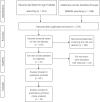Preoperative Prediction Power of Radiomics for Breast Cancer: A Systemic Review and Meta-Analysis
- PMID: 35299744
- PMCID: PMC8920972
- DOI: 10.3389/fonc.2022.837257
Preoperative Prediction Power of Radiomics for Breast Cancer: A Systemic Review and Meta-Analysis
Abstract
Background: To evaluate the preoperative predictive value of radiomics in the diagnosis of breast cancer (BC).
Methods: By searching PubMed and Embase libraries, our study identified 19 eligible studies. We conducted a meta-analysis to assess the differential value in the preoperative assessment of BC using radiomics methods.
Results: Nineteen radiomics studies focusing on the diagnostic efficacy of BC and involving 5865 patients were enrolled. The integrated sensitivity and specificity were 0.84 (95% CI: 0.80-0.87, I 2 = 76.44%) and 0.83 (95% CI: 0.78-0.87, I 2 = 81.79%), respectively. The AUC based on the SROC curve was 0.91, indicating a high diagnostic value.
Conclusion: Radiomics has shown excellent diagnostic performance in the preoperative prediction of BC and is expected to be a promising method in clinical practice.
Keywords: breast cancer; cancer prediction; meta-analysis; radiomics; systematic review.
Copyright © 2022 Li, Ye, Du, Cao, Wang, Liu, Zhu and Shen.
Conflict of interest statement
The authors declare that the research was conducted in the absence of any commercial or financial relationships that could be construed as a potential conflict of interest.
Figures




Similar articles
-
Radiomics for preoperative prediction of early recurrence in hepatocellular carcinoma: a meta-analysis.Front Oncol. 2023 Jun 7;13:1114983. doi: 10.3389/fonc.2023.1114983. eCollection 2023. Front Oncol. 2023. PMID: 37350952 Free PMC article.
-
Preoperative Prediction Power of Imaging Methods for Microvascular Invasion in Hepatocellular Carcinoma: A Systemic Review and Meta-Analysis.Front Oncol. 2020 Jun 26;10:887. doi: 10.3389/fonc.2020.00887. eCollection 2020. Front Oncol. 2020. PMID: 32676450 Free PMC article.
-
Ultrasound radiomics in the assessment of breast cancer molecular subtypes: A systematic review and meta-analysis.Med Ultrason. 2024 Nov 4. doi: 10.11152/mu-4449. Online ahead of print. Med Ultrason. 2024. PMID: 39705625 Review.
-
Exploring breast cancer response prediction to neoadjuvant systemic therapy using MRI-based radiomics: A systematic review.Eur J Radiol. 2019 Dec;121:108736. doi: 10.1016/j.ejrad.2019.108736. Epub 2019 Nov 6. Eur J Radiol. 2019. PMID: 31734639
-
Radiomics for Predicting Response of Neoadjuvant Chemotherapy in Nasopharyngeal Carcinoma: A Systematic Review and Meta-Analysis.Front Oncol. 2022 May 4;12:893103. doi: 10.3389/fonc.2022.893103. eCollection 2022. Front Oncol. 2022. PMID: 35600395 Free PMC article.
Cited by
-
Artificial Intelligence Performance in Image-Based Cancer Identification: Umbrella Review of Systematic Reviews.J Med Internet Res. 2025 Apr 1;27:e53567. doi: 10.2196/53567. J Med Internet Res. 2025. PMID: 40167239 Free PMC article.
-
Diagnostic performance of radiomics in predicting axillary lymph node metastasis in breast cancer: A systematic review and meta-analysis.Front Oncol. 2022 Nov 28;12:1046005. doi: 10.3389/fonc.2022.1046005. eCollection 2022. Front Oncol. 2022. PMID: 36518318 Free PMC article.
-
Intratumoral and peritumoral CT-based radiomics for predicting the microsatellite instability in gastric cancer.Abdom Radiol (NY). 2024 May;49(5):1363-1375. doi: 10.1007/s00261-023-04165-9. Epub 2024 Feb 2. Abdom Radiol (NY). 2024. PMID: 38305796
-
An overview of meta-analyses on radiomics: more evidence is needed to support clinical translation.Insights Imaging. 2023 Jun 19;14(1):111. doi: 10.1186/s13244-023-01437-2. Insights Imaging. 2023. PMID: 37336830 Free PMC article.
References
-
- Cancer Tomorrow . International Agency for Research on Cancer . Available at: http://gco.iarc.fr/tomorrow/graphicisotype?type=0&population=900&mode=po... (Accessed January 5, 2020).
Publication types
LinkOut - more resources
Full Text Sources

